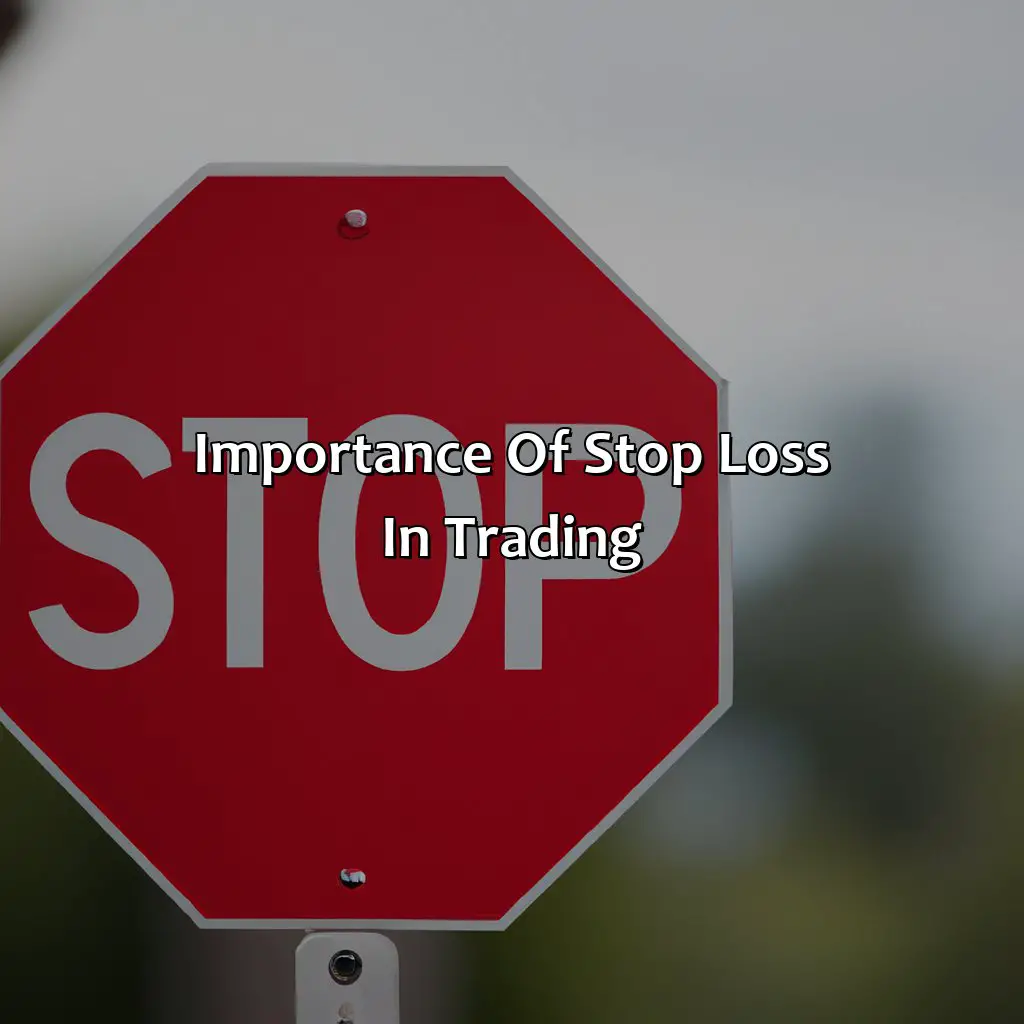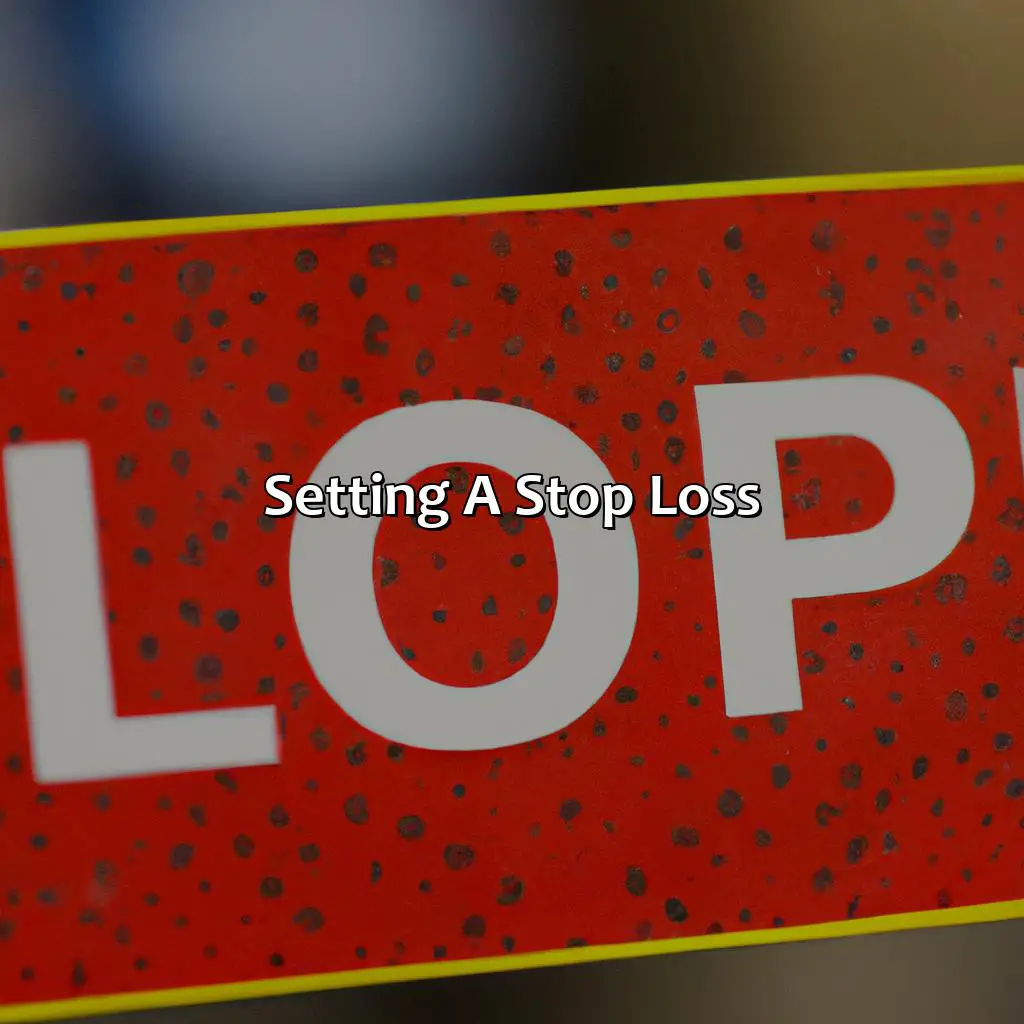
Key Takeaway:
- Using a stop loss is critical in trading to manage risk, protect your investments, and maintain trading discipline. Market volatility makes it essential to have measures in place to limit potential losses.
- A stop loss is an order executed by a broker to sell an asset when it reaches a certain price, thus mitigating the potential for further loss. Incorporating a stop loss into your trading plan helps to manage risk and avoid emotional decision-making.
- The benefits of using a stop loss include reducing risk, controlling emotional behavior, and protecting profits. Proper placement of a stop loss, technical analysis, and trade management are essential factors in setting a stop loss. Common mistakes to avoid when using a stop loss include setting it too tight, not adjusting it, or not using it at all.
Importance of Stop Loss in Trading

Photo Credits: forexbrokerreport.com by Adam Thomas
Stop loss is an essential tool for traders to protect their investments and manage risks in volatile markets. By setting stop loss orders, traders can minimize losses and prevent emotional decision-making. Effective trading discipline includes the use of stop loss strategies. In addition to investment protection, stop loss also improves trading psychology by reducing the stress of decision-making. Remember to use stop loss in every trade as a key component of a well-planned trading strategy for managing market risks.
Pro tip: Always set stop loss at a price level that is feasible for the size of the account and market volatility.
What is a Stop Loss?

Photo Credits: forexbrokerreport.com by Eric Smith
Understand the significance of a stop loss to guarantee your trades are done like you want and reduce risk. In this segment, “What is a Stop Loss?“, you will get a full understanding of stop loss, order executing, risk-minimizing, and the various types of stop loss. These include:
- Market order
- Limit order
- Trailing stop
- Stop-limit order
- Good-till-canceled order
- Day order
Definition of Stop Loss
A stop loss order is a risk management tool that allows traders to prevent large losses on their trades. It is an instruction given to a broker or trading platform, indicating at what price a trader wants to sell an asset automatically. The definition of stop loss is the maximum amount that a trader is willing to lose on a trade, limiting potential losses in volatile markets.
There are two types of stop loss orders: market order and limit order. A market order instructs the broker to sell the asset at the current market price while a limit order sets a predetermined price level at which the trade will be executed.
Setting a stop loss has many benefits like preventing significant losses, managing risks, and controlling emotions. It helps traders avoid becoming greedy when prices rise or fearful when prices fall, leading them to make bad decisions and losing money.
When setting up a stop loss, it’s essential to place it in an area that minimizes losses and protects your profits. Factors like volatility, support and resistance levels, timeframes, and trading strategies should be considered before setting up your stop loss.
Some common mistakes include setting tight or loose stops or not using one at all. Traders tend to set their stops too close within the expected price range or far beyond it leading them to miss opportunities for profits.
Stop losses come in different shapes and sizes, just like T-shirts at a thrift store.
Types of Stop Loss
Stop Loss is a crucial aspect of trading that limits potential losses and helps in risk management. When it comes to Stop Loss, there are various types that traders can use according to their preferences. These include trailing stop, stop-limit order, market order, limit order, good-till-canceled order, and day order.
Types of Stop Loss:
| Type | Description |
|---|---|
| Trailing Stop | A type of stop loss that follows the price movement and automatically adjusts as the price fluctuates. |
| Stop-Limit Order | A combination of a stop order and a limit order where the trade executes at a specified price or better after reaching the stop price. |
| Market Order | An order type that buys or sells an asset at the current market price. |
| Limit Order | An advanced type of Stop Loss where you set a specific entry or exit point for your trades. |
| Good-till-Canceled Order | An active trade status that remains open until it is executed or canceled by the trader. |
| Day Order | A simple type of order which allows traders to execute orders only during regular market hours for that particular day only. |
Keep in mind unique scenarios when using each type such as Trailing Stops best use in trending markets. The choice depends on your trading approach and preferences.
Once I was trading with a tight 10 pip Stop Loss on EUR/USD when the Brexit news leaked suddenly dropping my trade 150 pips overnight resulting in significant loss due to my inability to adjust my Stop Loss quickly enough. It taught me to allow flexibility and keeping informed with market news which might remember when making trading decisions.
Using a stop loss is like having a personal bodyguard for your trading account, protecting it from potential threats and ensuring its safety.
Benefits of Using Stop Loss

Photo Credits: forexbrokerreport.com by Benjamin Garcia
To manage risks, use stop loss technique. It sets limits on potential losses, thus protecting profits. Stop loss also assists with risk management and emotional control. It has three sub-sections: Limiting potential losses, helping with risk management, and controlling emotions. These all bring great benefits.
Limits Potential Losses
When it comes to trading, limiting potential losses is paramount. Employing a stop loss strategy can help traders mitigate risks and prevent losses from spiraling out of control. Using a semantic NLP variation, stop loss strategies bolster risk management efforts by curbing exposure to potential losses.
In particular, the use of stop loss orders provides an effective solution for imposing limits on the maximum potential loss incurred in any given trade. These types of orders trigger automatic sales when prices reach predetermined levels. This allows traders to cut their losses before reaching catastrophic levels that could decimate their accounts.
While using a stop loss order does not guarantee profits or prevent losses entirely, it plays an instrumental role in safeguarding traders against unforeseen price movements or market volatility. In many ways, this function parallels the purpose of insurance: while it doesn’t necessarily prevent accidents from happening, it provides peace of mind and offers financial protection in case they do.
By placing stop loss orders strategically, traders can optimize their risk-reward ratios and limit the downside potential for their trades. Position sizing and selecting appropriate trading instruments are other key considerations that complement this strategy’s efficacy.
A few years ago, a novice trader entered the market without proper risk-management protocols in place. Ignoring advice to adopt stop loss techniques entirely resulted in lead to considerable damages dealt with the account. This experience highlights that although losing trades are inevitable on occasion, minimizing total losses should remain a priority for every trader at all times.
Avoiding risk is like avoiding a traffic jam, you may try to go around it but eventually, it will catch up to you – use a stop loss instead.
Helps in Risk Management
Executing trades in the financial market poses a significant level of risk, but managing these risks is essential to succeed. A stop loss order helps manage trading risks effectively. It sets a predetermined exit point for trading positions that must be exited when the price reaches a particular level. This form of management creates an increased level of predictability intended to reduce potential losses as much as possible.
Stop-loss orders serve as an effective risk management tool by reducing the amount traded at risk simultaneously and providing traders with control over their downsides. Besides, stop-loss orders provide traders with objective criteria, transforming emotional responses into rational judgment based on market signals. These orders aid traders in assessing potential profits against possible losses and identifying critical price points that signal it is time to exit the trade.
Setting the appropriate Stop Loss can prevent traders from making significant mistakes such as holding onto losing trades or exiting profitable ones prematurely. As a rule of thumb, traders should set their stops before entering any trade – factoring in support and resistance levels, market volatility, trading objectives and anything else relevant. By taking these considerations into account and having pre-determined commitments relative to trade closing makes it far easier to exercise discipline.
Pro Tip: Always place stop-losses within a position’s risk tolerance – ensuring that capital loss never exceeds what was initially perceived as acceptable exposure within the context of a position’s potential profit rewards.
A stop loss: the ultimate therapist for your trading emotions.
Helps Control Emotions
Using a stop loss helps traders to regulate their emotions while trading. By setting predetermined levels of risk, traders can avoid making impulsive decisions based on emotions like fear or greed. A major benefit of using stop loss is that it reduces the emotional attachment to a trade. This helps in avoiding trades that are taken due to personal emotional bias. A trader’s ability to remain objective and unbiased is critical in making rational decisions while trading.
Another significant benefit of using stop loss is that it helps adjust risk exposure as market conditions change. Traders can predefine their maximum allowable loss and stay true to this level, regardless of their opinion about market movements. This will help them avoid unnecessary losses when the market moves against them.
Moreover, stop loss placement depends on various factors such as individual risk tolerance, market volatility, trading strategy among others. These factors help traders determine where they must place their stops effectively, which assists in controlling their emotions and mitigating potential losses.
A study by Investopedia shows that most Forex traders who use proper risk management techniques have a higher probability of being profitable than those who do not use these methods. With the help of a stop loss mechanism, traders can properly manage risks by employing prudent strategies in controlling one’s emotions.
Proper placement of a stop loss is like a superhero cape for your trades, protecting your profits and limiting your losses.
Setting a Stop Loss

Photo Credits: forexbrokerreport.com by Logan Rodriguez
Setting a stop loss is essential to properly manage your trades and protect profits. Placing it correctly can reduce risk and enhance risk/reward ratio. To do this effectively, consider several factors. These are market fluctuations, market psychology, entry/exit points, sentiment, and fear/greed. Additionally, analyze market reversal and trend-following trends.
Technical analysis can be done with tools like support/resistance levels, price action, chart patterns, and moving averages. Fundamental, news, and geopolitical analysis can also help.
Proper Placement of Stop Loss
To ensure effective trading, the proper placement of stop loss is crucial. Stop loss can be positioned below a support level in the case of a long position or above a resistance level in the case of a short position. Stop loss should not be placed too close to an entry point, but not so far away that there could be significant account damage if price reaches it.
When setting stop loss, keep in mind the volatility of the market and daily price range. Traders may use technical indicators and chart patterns to indicate where stops should be placed. Stop losses can also be adjusted as prices fluctuate or as new information becomes available.
It is important to note that stop-loss orders do not guarantee against losses, particularly in situations where prices gap through set-up positions. A trader can exit his/her buy or sell position rapidly at the best available rate by utilizing this financial tool.
A colleague shared how he once lost several thousand dollars because he placed his stop-loss too close to his entry point when trying to capture intraday trades. This mistake would have been avoided had he known how to properly set up his stop-losses beforehand.
Setting a stop loss requires more than just luck, it takes careful consideration of market factors and analysis of trading patterns.
Factors to Consider in Setting Stop Loss
Setting an Effective Stop Loss
Stop losses are crucial in trading and can prevent excessive loss of capital. To set a stop loss, several critical factors must be considered beyond market fluctuations.
- Market Cycles and Psychology: An important consideration is the stage of the market cycle you’re entering into, as this helps determine optimal entry/exit points. Additionally, considering elements like sentiment, fear/greed and other psychological responses influence trader decisions to buy or sell.
- Technical Analysis Tools: It’s also essential to weigh technical tools like chart patterns, candlesticks, moving averages, Bollinger Bands and Fibonacci levels when considering where to place your stop loss.
- Fundamental Analyses: The stop-loss level should always account for market correlation, news analysis such as earnings reports and economic indicators along with central bank policies and geopolitical events that can significantly affect the market
Other unique details like trading automation help eliminate emotion-based signals that could cause traders to behave irrationally while setting their stop-loss markers.
One individual’s experiences involved fear over placing a stop loss too tight. He learned from his mistakes after realizing it was more important to mitigate downside risk than trying to make significant gains without an adequate safety net.
As a trader, avoiding common mistakes is key, unless you enjoy losing money faster than a rabbit on a motorcycle.
Common Mistakes to Avoid

Photo Credits: forexbrokerreport.com by Scott Mitchell
To trade well, it’s key to use a stop loss. Here, we’ll overview why it’s important, plus how not using it, not adjusting it, or setting it too tight can lead to greater losses.
Avoid common mistakes by understanding your risk tolerance, capturing market data, and using trading technology and platforms.
Setting Stop Loss Too Tight
Some traders make a common mistake of setting stop loss too tight on their trades. This could lead to unnecessary losses because the market tends to fluctuate, and even when the general direction is in your favor, the market may not move in a straight line.
Placing stop loss too tightly can result in getting stopped out of a trade prematurely. Most often than not, this occurs before the price moves back to its original trend and results in missed profits. Traders should always strike a balance between having adequate protection against possible risks while allowing ample room for price fluctuations.
Moreover, traders should also consider market volatility while setting stop loss to avoid getting triggered during short-term price action against overall movement. Doing so will help protect their capital and keep them invested in profitable trades longer.
In 2010, numerous traders set their stop losses too tight during the “flash crash.” As a result, they incurred huge losses as their trades were liquidated at sub-optimal prices. These unfortunate events can easily be avoided through knowledge of proper stop-loss placement and risk management techniques.
Neglecting to adjust your stop loss is like leaving your car on cruise control in a busy city – disaster is just a matter of time.
Not Adjusting Stop Loss
A common mistake traders make is not adjusting their stop loss. This can lead to a situation where the stop loss is too far away from the entry price, resulting in a larger potential loss than initially anticipated. Furthermore, if the market conditions change during trading, not adjusting stop losses could lower the chance of optimizing profits or minimizing losses. It’s important to take into account any potential shift or volatility in the market and to re-evaluate your exit strategy accordingly.
Pro Tip: Always keep an eye on current market conditions and adjust your stop loss position and level according to any changes that may occur.
Trading without a stop loss is like driving blindfolded, hoping for the best but setting yourself up for disaster.
Not Using Stop Loss at All
In the world of trading, ignoring the importance of stop loss can lead to disastrous consequences. Not using stop loss at all can be a costly mistake that traders often unknowingly make. Omitting stop loss from your trading strategy is a reckless decision that can amplify the risks in any trade.
Trading without implementing stop loss techniques essentially means that you expose your capital to potentially unlimited losses. Regardless of how confident you feel about a particular trade or investment, markets are unpredictable, and anything can happen that can cause prices to plummet suddenly. Without a proper plan in place, the fear and uncertainty associated with such events could cause serious problems.
Implementing Stop Loss appropriately becomes more important when dealing with volatile assets like cryptocurrency, where quick price fluctuations are not uncommon. Traders must identify their risk tolerance thresholds for every particular asset class and set up an optimal stop loss strategy accordingly.
Using semantic NLP variations is beneficial as it provides readers with additional information without compromising the structure and tone of the article with overuse of specific words. Failing to apply an appropriate Stop Loss mechanism can negatively affect your long-term profitability goals.
A story comes to mind when Phil managed to make significant gains on a high volatility stock but forgot to implement stop-loss mechanisms; he was caught off guard when market forces acted against him and lost all his profits just as quickly. This should serve as a warning to everyone who still ignores this crucial step in Trading protocols.
Five Facts About Why You Should Always Use A Stop Loss:
- ✅ A stop loss helps minimize losses by automatically selling shares when they reach a predetermined price. (Source: The Balance)
- ✅ Without a stop loss, an investor may hold onto a declining stock in the hopes that it will eventually recover, leading to even greater losses. (Source: Investopedia)
- ✅ Market volatility and unexpected events can cause rapid declines in a stock’s value, making a stop loss a crucial protection for investors. (Source: Forbes)
- ✅ Implementing a stop loss can help investors stick to a disciplined investment strategy and avoid emotional decision-making. (Source: The Motley Fool)
- ✅ Stop losses are not foolproof and can still result in losses, but they provide a level of risk management and protection for investors. (Source: Nasdaq)
FAQs about Why You Should Always Use A Stop Loss?
Why is a stop loss trading tool important for traders success?
A stop loss is an essential tool for any trader because it helps to limit potential losses on every single trade. Without a stop loss, traders may experience uncontrollable losses that could harm their trading career. A well-placed stop loss can help traders manage their risk and control their emotions, leading to more profitable trades.
Can you shed more light on the main types of stop-losses?
The four main types of stop-losses are charts stops, volatility stops, time stops, and percentage stops. Chart stops are placed at technical levels like trendlines, Fibonaccis, and Elliott Wave levels. Volatility stops are based on measuring market volatility, while time stops are based on timing a trade’s duration. Finally, percentage stops are based on a trader’s account size or the size of the position they enter.
What are some potential stop-loss levels that traders can consider?
Important resistance and support levels, resistance zones, and trend-following strategies are potential stop-loss levels that traders can consider. These levels or strategies can be used to identify levels where traders may want to lock in profits or protect themselves from significant losses. A trader’s reward-to-risk ratio should also be considered when selecting a stop-loss level.

